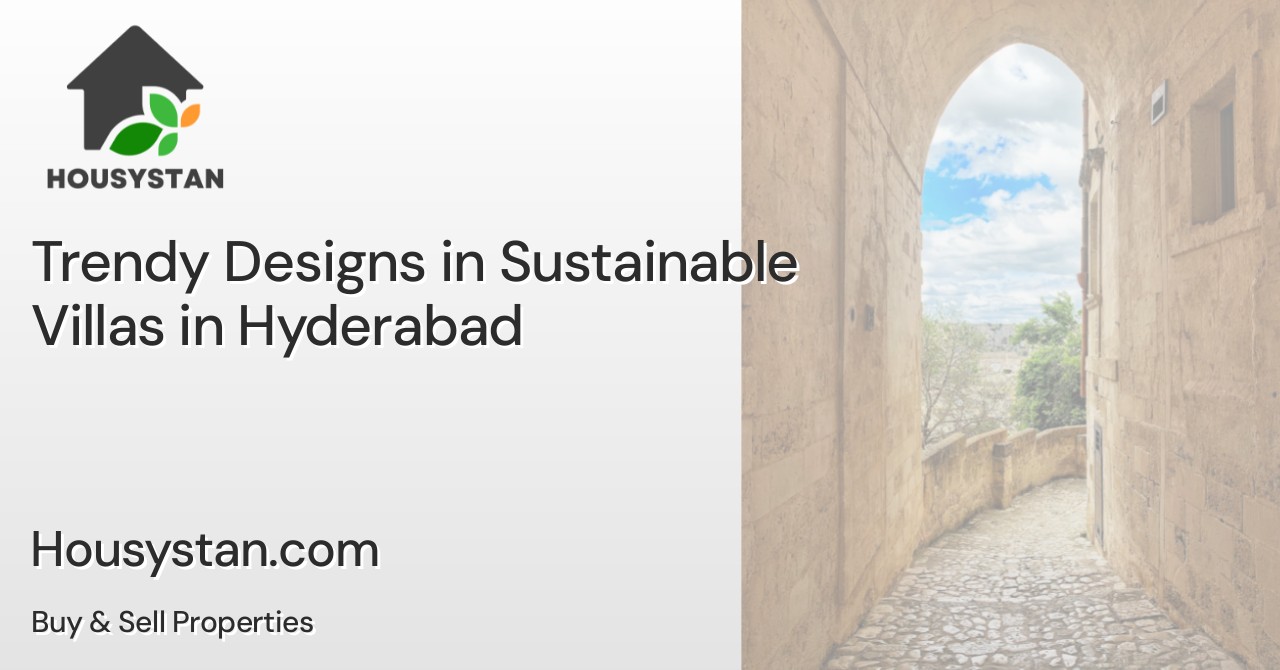Trendy Designs in Sustainable Villas in Hyderabad
Read latest blogs and articles from Housystan

The Information mentioned here was last updated on:
20/1/2026Trendy Designs in Sustainable Villas in Hyderabad: A Guide to Eco-Friendly Living
Introduction: What Makes a Villa Sustainable?
In recent years, the concept of sustainable living has gained momentum, especially in urban areas like Hyderabad. A city known for its rapid development and tech boom, Hyderabad is seeing an increasing demand for sustainable villas. But what exactly does it mean for a villa to be sustainable? It’s about designing homes that minimize environmental impact, optimize energy use, and provide a comfortable living space while conserving natural resources. In this blog, we explore the trendy designs that are making sustainable villas in Hyderabad the choice for eco-conscious homeowners.
- Verified Tenants/Buyers
- Unlimited Property Listing
- Zero subscription/charges fee
The Growing Popularity of Green Architecture
Sustainability has become a key factor in the architectural landscape of Hyderabad. Green architecture is not just a trend, but a necessary shift towards more environmentally responsible building practices. This involves the use of resources efficiently while optimizing the health and comfort of the building occupants. Homebuyers are increasingly preferring eco-friendly materials, energy-efficient appliances, and water-saving technologies. Not only do these features help reduce the carbon footprint, but they also lower utility bills and enhance the quality of life.
Biophilic Design: Bringing Nature Indoors
One of the most popular trends in sustainable villas is biophilic design, a concept that integrates nature into living spaces. This approach is grounded in the understanding that humans have a strong connection with the natural environment. Sustainable villas in Hyderabad often feature large windows, indoor gardens, and natural ventilation systems. These elements help facilitate a flow of natural light and fresh air, creating a healthier and more inviting environment. Biophilic design not only reduces the need for artificial lighting and air conditioning but also promotes mental well-being and relaxation.
Energy Efficiency and Renewable Energy Sources
In the quest for sustainability, energy efficiency is paramount. Modern villas in Hyderabad are equipped with solar panels, which are an excellent source of renewable energy. This harnesses the abundant sunlight in Hyderabad, significantly reducing the dependence on conventional electricity. Features like LED lighting, energy-efficient appliances, and smart home technologies contribute to reducing energy consumption. By implementing such technologies, homeowners can enjoy modern conveniences without compromising sustainability.
Water Conservation: A Key Priority
Hyderabad, like many other cities, faces water scarcity challenges. Thus, water conservation is a critical aspect of sustainable villa designs. Rainwater harvesting systems and greywater recycling setups are becoming commonplace in eco-friendly homes. These systems capture rainwater and treat wastewater for reuse in gardens and flushing systems. Additionally, water-efficient plumbing fixtures are a standard, helping to further conserve this precious resource.
Sustainable Materials: Building for the Future
Using sustainable materials is another hallmark of eco-friendly villa designs in Hyderabad. Materials like bamboo, reclaimed wood, and recycled metal are popular choices. These materials are not only environmentally friendly but also durable, ensuring longevity. There is also a growing trend towards using locally sourced materials, which reduces the carbon footprint associated with transportation and supports local economies.
Smart Home Technology: Enhancing Eco-Friendly Living
Incorporating smart technology is a decisive factor in modern sustainable villa designs. Smart home systems allow homeowners to control lighting, heating, and security systems remotely. Smart thermostats and automated lighting systems adjust based on occupancy and time of day, optimizing energy use. This blend of technology and sustainability ensures a reduction in both environmental impact and energy costs.
Landscaping for Sustainability
Landscaping is an essential element of sustainable villa design, facilitating both aesthetics and environmental benefits. Native plants and xeriscaping (landscaping that reduces or eliminates the need for irrigation) are gaining popularity. These practices not only conserve water but also attract local wildlife, contributing to biodiversity. Eco-friendly waste management systems, like composting bins, can also be integrated into these landscapes.
The Role of Insulation and Ventilation
Proper insulation and ventilation are crucial factors in achieving energy efficiency. Sustainable villas in Hyderabad are designed with materials that offer high thermal resistance, reducing the need for extensive heating or cooling. Similarly, natural ventilation systems help maintain indoor air quality, eliminating the need for mechanical ventilation solutions that consume power.
Community Aspects: Creating Sustainable Neighborhoods
Sustainable villa communities are rising in prominence in Hyderabad. These communities focus not only on individual homes but also on shared resources like community gardens and renewable energy sources. Many such communities are designed to promote social interaction and provide communal spaces that encourage a sustainable lifestyle.
Urban Innovation and Sustainability in Hyderabad
Hyderabad is a city of innovation, and this extends to its approach to sustainable development. Developers are increasingly incorporating green certifications and adherence to environmental guidelines in their projects. Initiatives like smart community planning, urban green spaces, and efficient public transport systems complement the move towards eco-friendly living environments.
Conclusion: The Future of Sustainable Living in Hyderabad
While this piece doesn't formally conclude, it's clear that sustainable villa designs in Hyderabad are essential to the city's future. As interest in eco-friendly housing grows, innovative and practical solutions are turning sustainable living from an ideal into a reality. By making conscious choices around design, materials, and technology, homeowners in Hyderabad are leading the way in green living. This emphasis on sustainability is not just about meeting current needs—it's about preserving resources and creating a cleaner, healthier world for future generations.